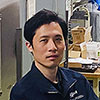X-raying the Earth’s magnetosphere with the world’s lightest X-ray telescope using cutting-edge MEMS technologies
Jan. 22, 2024 | Aerospace Project Research Associate, ISAS people
Research Summary

In the 1990s, the German X-ray astronomy satellite “ROSAT” experienced an unexplained noise that suddenly brightened within only a few days. Astronomers embarked on an investigation for pinpointing its origin. The most credible explanation was that solar wind ions (e.g., fully ionized carbon and oxygen) generate X-ray signals by striping an electron from neutrals in the Earth’s exosphere*1 (Figure 1). This phenomenon is referred to as “charge exchange*2.” In the 2000s, this explanation gained stronger support through precise observations with recent X-ray astronomy satellites like “Suzaku.” These observations confirmed a distinct distribution of emission lines resulting from charge exchange reactions (e.g., Fujimoto et al. 2007, Publ. Astron. Soc. Japan).

The Earth’s magnetosphere*3 is formed by the interaction between the solar wind and Earth’s magnetic field. When solar explosive events (e.g., flares and coronal mass ejections) occur, they concentrate solar wind particles on the dayside of the Earth’s magnetosphere, resulting in brightened charge exchange emissions. This fact makes it possible to visualize the Earth’s magnetosphere when observed from the vicinity of the Moon (Figure 2). The Japanese X-ray astronomy satellite “Suzaku” has recently detected charge exchange events associated with the Earth’s magnetosphere (e.g., Ishi et al. 2023, Publ. Astron. Soc. Japan). However, these observations suffer from limitations due to their narrow perspectives and constrained viewpoints around the Earth.
To address these limitations, the “GEO-X (GEOspace X-ray imager) mission,” led by Tokyo Metropolitan University and the Institute of Space and Astronautical Science, is currently under development. This mission has an ambitious goal to achieve an unprecedented feat of “X-raying the Earth’s magnetosphere.” Leveraging ultra-small satellites that have been employed in recent space and planetary explorations, our strategy involves observations from an altitude comparable to that of the Moon's orbit. We plan to launch it as early as the Japanese fiscal year 2024-2025.

A key technology is an “ultralightweight X-ray telescope,” designed for magnetosphere observations while adhering to limited resources of ultra-small satellites (Figure 3). This telescope employs cutting-edge MEMS*4 technologies to create micro-pores on silicon wafers. Their sidewalls are utilized as X-ray mirrors. This “micro-pore” method significantly reduces weight compared to traditional telescopes. Our telescope weighs only 5 g (less than 100 g even when including a support ring). Despite its lightweight and compact design, it rivals the performance of larger telescopes like that onboard “Suzaku,” making it suitable for deployment on ultra-small satellites.

I am involved in the development of the GEO-X telescope, collaborating with both students and staff at Tokyo Metropolitan University. To fabricate this telescope, we utilize the MEMS facilities at the Institute of Space and Astronautical Science. Additionally, we collaborate with other universities and research institutions to access their specialized capabilities. We then evaluate its reflection and imaging quality at the beamline of the Institute of Space and Astronautical Science (Figure 4). I am responsible for operating and maintaining such space radiation equipment. The Institute of Space and Astronautical Science also provides a lot of resources for testing our telescope under launch and space environments.
While challenges arise from unexpected experimental results, it is the best part of overcoming such obstacles and completing our telescope. The awareness that our telescope will venture into space to reveal mysteries gives great rewards for me. The experience at the Institute of Space and Astronautical Science will undoubtedly prove invaluable for the forthcoming era of space and planetary explorations.
Terminologies
- *1 exosphere : The uppermost part of the Earth’s atmosphere at altitudes above 500 km. It consists mainly of lighter atoms such as hydrogen and helium from lower atmospheres.
- *2 charge exchange : A reaction where an electron transfers from one particle to the other when two particles collide. The electron moves to higher energy states and emits characteristic X-rays when it transitions to lower energy states.
- *3 magnetosphere : A region where the Earth’s magnetic field becomes dominant. It extends from altitudes of 1,000 km to tens of thousands of km. This “barrier” provides protection from direct impacts of energetic solar wind particles.
- *4 MEMS : Abbreviation for “Micro Electro Mechanical Systems,” which involves processing substrates like silicon on a scale of μm.


 ISHI Daiki / Inter-University Research and Facility Management Group, ISAS
ISHI Daiki / Inter-University Research and Facility Management Group, ISAS